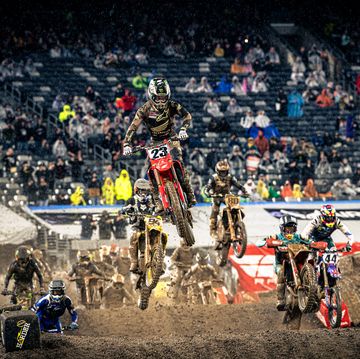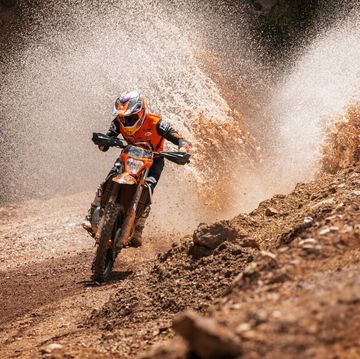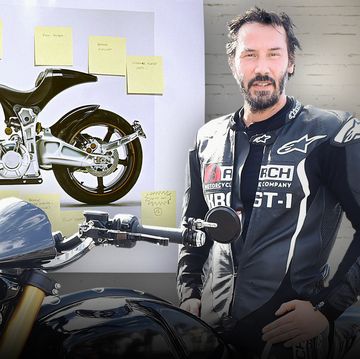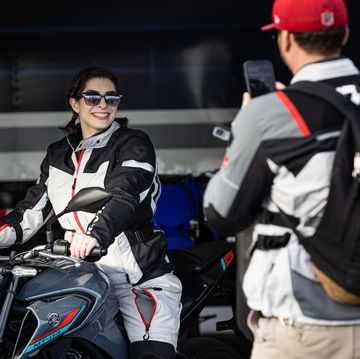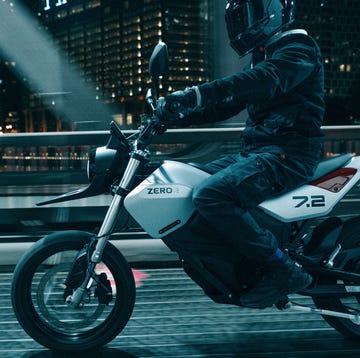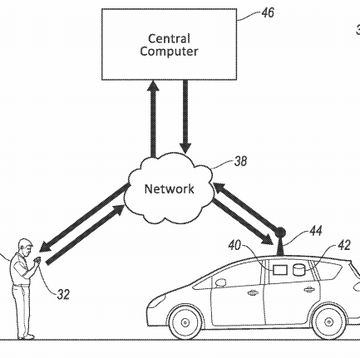A quick look around is all you need to think the two-stroke engine is dead. Exhaust smokers no longer brapp their way past outdoor cafés or over twisty mountain passes. You don't even see two-strokes on the motocross track these days. There might be the odd moped exploring New York or San Francisco, but even modern weed whackers eschew the once-common two-stroke setup.
KTM wants to bring the two-stroke back. The Austrian motorcycle company just introduced a line of newn fuel-injected two-stroke bikes that aim to deliver the benefits of the engine—namely, raw power and light weight—while minimizing the high emissions and fuel inefficiency that has sidelined the technology.
Two Step
Two-stroke engines fire on every crankshaft cycle rather than every other cycle, meaning they can make almost 50 percent more power than four-strokes for a given displacement. In other words, two-strokes offer more power with less weight. Part of that extra power comes from a two-stroke engine's capacity to more easily rev up to higher rpm than a four-stroke, which needs to contend with additional moving parts (valves and camshafts) to control the flow of air and fuel into the cylinders.
However, the two-stroke comes with an Achilles heel. Small amounts of fuel passing through the open ports of the cylinder are not burned, resulting in high fuel consumption and elevated emissions. Furthermore, two-strokes burn an oil and gas mixture that also lubricates the engine, and the resulting clouds of blue exhaust aren't exactly clean. In California, emissions testing even for off-road bikes has rendered two-strokes all but illegal. Two-strokes are nimble, fast, and fun—but also dirty and inefficient.
These shortcomings of the two-stroke have transformed motocross racing. Back in 1998, the American Motorcycle Association introduced a rule that allowed extra engine capacity—450cc rather than 250cc—for four-stroke motocross race bikes, and manufacturers got to work. With larger displacement, the 450s gained more power and began to dominate the race circuit. By 2009, all manufacturers were fielding four-stroke race bikes exclusively, and four-stroke development outpaced two-strokes. Today, all major dirt bike manufacturers produce fuel-injected, 450cc motocross bikes, and Suzuki and Honda don't even make two-stroke 250s anymore.
Bringing Back the Brapp
What if you could keep the good and nix the bad? The holy grail of off-road motorcycling is a reliable, high-performance, fuel-injected two-stroke engine with optimized combustion so unburned fuel doesn't foul exhaust fumes so horribly. KTM is going for just that with its new bikes. At the enormous open-pit Erzberg iron mine in Eisenerz, Austria, the company launched its new line of fuel-injected two-stroke enduro racers.
Why enduro? This is one competition that never gave up on the two-stroke. Its riders race against the clock, threading their bikes over twisty tracks, muddy roots, and steep sections littered with large rocks. In such tough conditions, the two-stroke has clear advantages: low weight, high agility, and snappy throttle response. Even though FIM World Enduro Championship regulations give four-strokes a displacement advantage similar to that of the AMA's rulebook, the majority of enduro racers and weekend warriors still opt for nimble, carbureted two-strokes.
Erzberg is a fitting place for the launch. It's the home of the Erzberg Rodeo, widely considered the toughest "Hard Enduro" event in the world. Competitors battle their way up steep hills and through brutal boulder sections in the mine. KTM reckons it's the perfect place to torture test the new bikes.
KTM is introducing two new fuel-injected bikes in Europe, the 2018 250 EXC TPI and the 2018 300 EXC TPI, while the U.S. will get limited quantities of the 2018 250 XC-W TPI later this year. The three new models have their carburetors replaced with KTM's new Transfer Port Injection system, which uses electronically-controlled injectors to squirt fuel into transfer ports leading to the cylinders. Compared to carburetors, the TPI system is said to reduce fuel consumption during low speeds by as much as 40 percent, though consumption is unchanged at wide-open throttle. The TPI system also eliminates the need for pre-mixed fuel which helps with that pesky emissions problem.
2018 KTM 300 EXC TPI Specs
Engine
- 1-cylinder, 2-stroke
- Displacement: 293.2 cm³
- Stroke/Bore: 72 mm
- Primary Drive: 26:73
- Secondary Gear Ratio: 14:50
Frame
- Chrome-moly steel
- Cast aluminum swingarm
- Front Suspension: WP Xplor 48 upside-down fork (300 mm travel)
- Rear Suspension: KTM Progressive Damping System (PDS) (310 mm travel)
Chassis
- Dry Weight: 103 kg (227 lbs)
- Wheel Base: 1482 mm
- Ground Clearance: 370 mm
- Seat Height: 960 mm
- Steering Head Angle: 63.5º
- Tank Capacity: 9 liters (2.38 gallons)
- Front Brake Disc Diameter: 260 mm
- Rear Brake Disc Diameter: 220 mm
Engineers at KTM have had to upgrade the rest of the bike to eke maximum performance out of new TPI fueling system. The new bikes benefit from a new throttle body and electronic control unit (ECU) that modifies ignition timing and fuel injection on the fly. Changes to the engine include a new cylinder, airbox, and a revised oil pump. Even the frame has changed—the TPI bikes include integrated oil tanks.
"[TPI bikes] make more or less the exactly the same power numbers as the carbureted bikes," says Michael Viertlmayr, KTM's lead engineer for off-road and motocross engines. "The power delivery at wide-open throttle is very similar, and the tractability is much better in the lower load areas."
One question we had about the new bikes: Why go with a transfer port system rather than direct fuel injection?
"Of course, we have investigated direct injection systems," says Viertlmayr. "However, there were major downsides in terms of fuel air mixture, preparation, atomization of the fuel, and rideability—also with piston longevity. Instead of direct injection, we decided on transfer port injection. With TPI you have better fuel atomization and air/fuel mixture preparation."
The TPI bikes also have an oil system that's different from conventional two-strokes. No longer does the carb fill the crankcase with vaporized premix. As Viertlmayr explains: "The new bikes have a separate lubrication system, meaning there is an oil pump that is controlled by the ECU, and in the ECU there is a mapping that controls the oil pump. We can control the amount of oil that comes into the engine in every load and rpm condition."
The Future of Two-Strokes?
Though the first riding impressions of the new system have been positive, there are always reliability risks with any new technology—especially during the first year of production. Even if KTM's TPI system works perfectly, many two-stroke purists are not going to be early adopters. The TPI bikes will likely cost around $500 more than their carbureted counterparts. There is also a five-pound weight penalty for the additional components, and the bikes are more complex for garage tinkerers.
Still, KTM has cleaned up the two-stroke and dragged it into the future. The world's first series-production, fuel-injected two-stroke dirt bike is finally here. For about $9,000, KTM has given us a bike that takes less wrenching, uses less gas and oil, and is just as fun to ride as any high-revving two-stroke. Prospective off-road riders should take a serious look at this bike. KTM's TPI technology is patented, but you can expect competitors to develop similar fuel-injected two-strokes in the coming years.
Looking forward further into the future, we hope that these clean, fuel-injected, two-stroke engines live up to the hype. If so, they might just find their way into street-legal machines. We're imagining a new crop of 300cc single engine sport bikes that can compete with the middle-weight four strokes. Or how about a 500cc two-stroke twin in an ultra-light adventure bike that harks back to Yamaha's TDR 250?
For high-performance and agile riding machines, the two-stroke might be roaring back to life.








